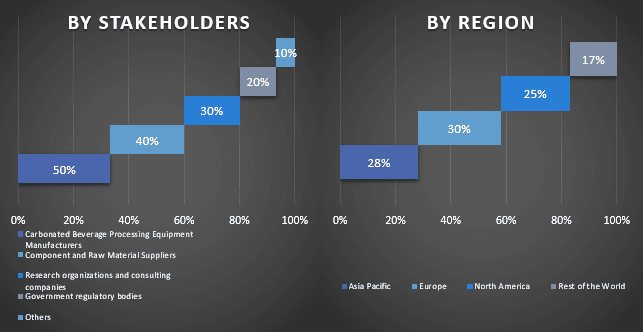- Startseite
- Über uns
- Industrie
- Dienstleistungen
- Lesen
- Kontaktieren Sie uns
Markt für Anlagen zur Verarbeitung von kohlensäurehaltigen Getränken: Aktuelle Analyse und Prognose (2022-2028)
Schwerpunkt auf Getränkeart (Aromatisierte Getränke, Functional Drinks, Alkoholische Getränke, Alkoholfreie Getränke); Gerätetyp (Wärmetauscher, Mischer und Rührwerke, Karbonisierungsanlagen, Zuckerlöser, Sonstige); und Region/Land

Es wird erwartet, dass der Markt für Geräte zur Verarbeitung kohlensäurehaltiger Getränke im Zeitraum 2022-2028 eine CAGR von ca. 5 % verzeichnen wird. Kohlensäurehaltige Getränke sind Getränke, die aufgrund des Vorhandenseins von Kohlendioxidgas Blasen und Kohlensäure bilden. Die Karbonisierung ist der Prozess, bei dem sich Kohlendioxid in Wasser löst. Die maximale Menge an Kohlendioxid, die gemischt werden kann, beträgt 8 Gramm pro Liter Wasser (g/l). Zu den kohlensäurehaltigen Getränken gehören Limonade, Cola, abgefülltes Wasser und andere kohlensäurehaltige Getränke. Limonaden enthalten normalerweise kohlensäurehaltiges Wasser, Aromen, Farben und Süßstoffe. Zu den verschiedenen Geräten, die bei der Herstellung von kohlensäurehaltigen Getränken verwendet werden, gehören Zuckerlöser, Karbonatoren, Mischer und Blender, Filteranlagen, Wärmetauscher und Entgasungsanlagen. Die zunehmende Akzeptanz von Geräten zur Verarbeitung kohlensäurehaltiger Getränke ist auf die weltweit steigende Nachfrage nach kohlensäurehaltigen Erfrischungsgetränken zurückzuführen. Darüber hinaus fördern Fortschritte bei der Herstellung und Verarbeitung von kohlensäurehaltigen Getränken das Wachstum des Marktes. Laut der Umfrage werden in den Vereinigten Staaten im Jahr 2020 mehr als 40 Gallonen kohlensäurehaltige Erfrischungsgetränke und kalte Getränke von den Verbrauchern konsumiert. Die weltweit steigende Nachfrage nach kohlensäurehaltigen Getränken führt zu einer wachsenden Nachfrage nach Geräten zur Verarbeitung kohlensäurehaltiger Getränke und wird in der kommenden Zeit ebenfalls zum Wachstum des Marktes beitragen. Darüber hinaus wird erwartet, dass der Markt für Geräte zur Verarbeitung kohlensäurehaltiger Getränke aufgrund des wachsenden Bewusstseins für die Verwendung von Geräten zur Verarbeitung kohlensäurehaltiger Getränke, des technologischen Fortschritts und der Innovation bei Geräten zur Verarbeitung kohlensäurehaltiger Getränke, der steigenden Kaufkraft der Verbraucher und der Verfügbarkeit von maßgeschneiderten, gesunden, zuckerfreien kohlensäurehaltigen Getränken wachsen wird. Einige der Einschränkungen auf dem Markt, darunter die Abwassererzeugung und der hohe Energieverbrauch, behindern jedoch das Wachstum dieses Marktes auf der ganzen Welt.
Die Verbraucher werden gesundheitsbewusster und sind bereit, Geld für gesunde Produkte auszugeben. Die Marktteilnehmer konzentrieren sich auf die Verbesserung ihrer Produktportfolios, indem sie zuckerarme, cholesterinarme, fettarme und geschmackvolle kohlensäurehaltige Getränke entwickeln. Daher haben die Marktteilnehmer Initiativen ergriffen und stark investiert, um ihr Geschäft durch die Einführung neuer Getränke mit essentiellen Mikronährstoffen zu erweitern, die den Markt für Geräte zur Verarbeitung kohlensäurehaltiger Getränke ergänzen. Zum Beispiel kündigte Koch Membrane Systems, ein globaler Hersteller innovativer Membranfiltrationslösungen, im April 2019 die Einführung der TIDAL Forward Osmosis (FO)-Technologie an, die für Anwendungen in den Bereichen Lebensmittel, Getränke und Biowissenschaften entwickelt wurde. Die neuartige Technologie ermöglicht die Produktkonzentration ohne Hitze.
Alfa Laval Corporate AB, VAN DER MOLEN GMBH, KHS Gruppe, GEA Group Aktiengesellschaft, Krones AG, SPX FLOW Inc, Bucher Industries AG, John Bean Technologies Corporation, Pentair plc, Statco Engineering & Fabricators Inc. sind einige der wichtigsten Akteure auf dem Markt. Mehrere Fusionen und Übernahmen sowie Partnerschaften wurden von diesen Akteuren eingegangen, um Kunden mit Hightech- und innovativen Produkten/Technologien zu unterstützen.
Im Bericht dargestellte Einblicke
"Unter den Getränkesorten machte die Kategorie der funktionellen Getränke im Jahr 2020 den größten Anteil am Markt aus"
Basierend auf der Getränkesorte ist der Markt für Geräte zur Verarbeitung kohlensäurehaltiger Getränke in aromatisierte Getränke, funktionelle Getränke, alkoholische Getränke und nicht-alkoholische Getränke unterteilt. Das Segment der funktionellen Getränke machte einen bedeutenden Marktanteil aus, und es wird geschätzt, dass es im prognostizierten Zeitraum aufgrund der steigenden Nachfrage nach funktionellen Getränken, die essentielle Mikronährstoffe enthalten, und gebrauchsfertigen Getränken für den geschäftigen Lebensstil der Verbraucher rasant wachsen wird. Darüber hinaus werden die Verbrauchertrends hin zu gesunden Getränken das Wachstum von funktionellen Getränken in diesem Markt vorantreiben.
"Unter den Gerätetypen wird erwartet, dass die Zuckerlöser im Prognosezeitraum ein beträchtliches CAGR verzeichnen werden"
Basierend auf dem Gerätetyp ist der Markt in Wärmetauscher, Blender und Mischer, Karbonisierungsgeräte, Zuckerlöser und andere unterteilt. Das Segment der Zuckerlöser eroberte einen beträchtlichen Marktanteil, und es wird erwartet, dass es im Prognosezeitraum mit einer beträchtlichen CAGR wachsen wird. Das Auflösen und Behandeln von Zucker ist eine der wichtigsten und kritischsten Phasen bei der Verarbeitung von kohlensäurehaltigen Erfrischungsgetränken. Das zunehmende Gesundheitsbewusstsein der Verbraucher hat das Wachstum des Marktes für kalorienarme kohlensäurehaltige Getränke angeheizt, was wahrscheinlich das Wachstum des Segments unterstützen wird. Darüber hinaus werden viele Länder in den kommenden Jahren kalorienarme Getränke einführen, was den Markt für Geräte zur Verarbeitung kohlensäurehaltiger Getränke ankurbeln wird. Dem weitverbreiteten Trend folgend, bringen sogar Alkoholunternehmen kalorienarme Getränke für die Verbraucher auf den Markt.
"APAC wird im Prognosezeitraum ein signifikantes Wachstum verzeichnen"
Für ein besseres Verständnis der Marktdynamik des Marktes für Geräte zur Verarbeitung kohlensäurehaltiger Getränke wurde eine detaillierte Analyse für verschiedene Regionen auf der ganzen Welt durchgeführt, darunter Nordamerika (die USA, Kanada und das restliche Nordamerika), Europa (Deutschland, Frankreich, Spanien, Vereinigtes Königreich, Italien und das restliche Europa), Asien-Pazifik (China, Indien, Australien, Japan und das restliche APAC), Rest der Welt. Der asiatisch-pazifische Raum stellt einen der wichtigsten Märkte für die Geräte zur Verarbeitung kohlensäurehaltiger Getränke dar und generierte Einnahmen aufgrund der Verfügbarkeit von Ressourcen zu niedrigen Kosten und einer qualifizierten Belegschaft sowie der steigenden Nachfrage nach Geräten zur Verarbeitung kohlensäurehaltiger Getränke in der APAC-Region.
Gründe für den Kauf dieses Berichts:
- Die Studie umfasst eine Marktdimensionierungs- und Prognoseanalyse, die von authentifizierten wichtigen Branchenexperten validiert wurde.
- Der Bericht bietet einen schnellen Überblick über die gesamte Branchenleistung auf einen Blick.
- Der Bericht enthält eine eingehende Analyse der wichtigsten Branchenkollegen mit einem primären Fokus auf wichtige Finanzdaten, Produktportfolios, Expansionsstrategien und aktuelle Entwicklungen.
- Detaillierte Untersuchung der Treiber, Beschränkungen, wichtigsten Trends und Chancen, die in der Branche vorherrschen.
- Die Studie deckt den Markt umfassend über verschiedene Segmente hinweg ab.
- Tiefgreifende regionale Analyse der Branche.
Anpassungsoptionen:
Der globale Markt für Geräte zur Verarbeitung kohlensäurehaltiger Getränke kann gemäß den Anforderungen oder anderen Marktsegmenten weiter angepasst werden. Darüber hinaus versteht UMI, dass Sie möglicherweise Ihre eigenen geschäftlichen Anforderungen haben. Nehmen Sie daher Kontakt mit uns auf, um einen Bericht zu erhalten, der vollständig auf Ihre Bedürfnisse zugeschnitten ist.
Inhaltsverzeichnis
Forschungs methodik für die globale Marktanalyse für Anlagen zur Verarbeitung von kohlensäurehaltigen Getränken (2022-2028)
Die Analyse des historischen Marktes, die Schätzung des aktuellen Marktes und die Prognose des zukünftigen Marktes für den globalen Markt für Anlagen zur Verarbeitung von kohlensäurehaltigen Getränken waren die drei wichtigsten Schritte, die unternommen wurden, um die Einführung von Anlagen zur Verarbeitung von kohlensäurehaltigen Getränken in den wichtigsten Regionen weltweit zu erstellen und zu analysieren. Es wurden umfassende Sekundärrecherchen durchgeführt, um die historischen Marktzahlen zu sammeln und die aktuelle Marktgröße zu schätzen. Zweitens wurden zahlreiche Erkenntnisse und Annahmen berücksichtigt, um diese Erkenntnisse zu validieren. Darüber hinaus wurden umfassende Primärinterviews mit Branchenexperten entlang der Wertschöpfungskette des globalen Marktes für Anlagen zur Verarbeitung von kohlensäurehaltigen Getränken geführt. Nach der Annahme und Validierung der Marktzahlen durch Primärinterviews wendeten wir einen Top-Down-/Bottom-Up-Ansatz an, um die vollständige Marktgröße zu prognostizieren. Danach wurden Marktaufschlüsselungs- und Datentriangulationsmethoden angewendet, um die Marktgröße von Segmenten und Untersegmenten, auf die sich die Branche bezieht, zu schätzen und zu analysieren. Die detaillierte Methodik wird im Folgenden erläutert:
Analyse der historischen Marktgröße
Schritt 1: Eingehende Untersuchung von Sekundärquellen:
Es wurde eine detaillierte Sekundärstudie durchgeführt, um die historische Marktgröße des Marktes für Anlagen zur Verarbeitung von kohlensäurehaltigen Getränken durch unternehmensinterne Quellen wie Jahresberichte und Finanzberichte, Leistungsvorträge, Pressemitteilungen usw. und externe Quellen wie Fachzeitschriften, Nachrichten und Artikel, Regierungsveröffentlichungen, Wettbewerbsveröffentlichungen, Sektorberichte, Datenbanken von Drittanbietern und andere glaubwürdige Veröffentlichungen zu erhalten.
Schritt 2: Marktsegmentierung:
Nachdem wir die historische Marktgröße des Marktes für Anlagen zur Verarbeitung von kohlensäurehaltigen Getränken erhalten hatten, führten wir eine detaillierte Sekundäranalyse durch, um historische Markteinblicke und Anteile für verschiedene Segmente und Untersegmente für wichtige Regionen zu sammeln. Zu den wichtigsten im Bericht enthaltenen Segmenten gehören die Getränkeart und der Anlagentyp. Darüber hinaus wurden Analysen auf Länderebene durchgeführt, um die allgemeine Akzeptanz von Testmodellen in dieser Region zu bewerten.
Schritt 3: Faktorenanalyse:
Nachdem wir die historische Marktgröße verschiedener Segmente und Untersegmente ermittelt hatten, führten wir eine detaillierte Faktorenanalyse durch, um die aktuelle Marktgröße des Marktes für Anlagen zur Verarbeitung von kohlensäurehaltigen Getränken zu schätzen. Darüber hinaus führten wir eine Faktorenanalyse unter Verwendung abhängiger und unabhängiger Variablen durch, wie z. B. die steigende Nachfrage nach Getränken mit weniger Fetten und Cholesterin, die wachsende Erwerbsbevölkerung und die technologischen Fortschritte bei den Anlagen für kohlensäurehaltige Getränke weltweit. Es wurde eine gründliche Analyse der Angebots- und Nachfrageseite unter Berücksichtigung der wichtigsten Partnerschaften, Fusionen und Übernahmen, Geschäftsausweitungen und Produkteinführungen im Sektor der Anlagen zur Verarbeitung von kohlensäurehaltigen Getränken auf der ganzen Welt durchgeführt.
Aktuelle Marktzgrößenschätzung und -prognose
Aktuelle Marktgröße: Basierend auf den umsetzbaren Erkenntnissen aus den oben genannten 3 Schritten ermittelten wir die aktuelle Marktgröße, die wichtigsten Akteure auf dem globalen Markt für Anlagen zur Verarbeitung von kohlensäurehaltigen Getränken und die Marktanteile der Segmente. Alle erforderlichen prozentualen Anteile und Marktaufschlüsselungen wurden unter Verwendung des oben genannten sekundären Ansatzes ermittelt und durch Primärinterviews verifiziert.
Schätzung & Prognose: Für die Marktschätzung und -prognose wurden verschiedenen Faktoren Gewichte zugewiesen, darunter Treiber & Trends, Einschränkungen und Möglichkeiten, die den Stakeholdern zur Verfügung stehen. Nach der Analyse dieser Faktoren wurden relevante Prognosetechniken, d. h. ein Top-Down-/Bottom-Up-Ansatz, angewendet, um die Marktprognose für etwa 2027 für verschiedene Segmente und Untersegmente in den wichtigsten Märkten weltweit zu erstellen. Die Forschungsmethodik zur Schätzung der Marktgröße umfasst:
- Die Marktgröße der Branche in Bezug auf den Umsatz (USD) und die Akzeptanzrate des Marktes für Anlagen zur Verarbeitung von kohlensäurehaltigen Getränken in den wichtigsten Märkten im Inland
- Alle prozentualen Anteile, Aufteilungen und Aufschlüsselungen von Marktsegmenten und Untersegmenten
- Die wichtigsten Akteure auf dem globalen Markt für Anlagen zur Verarbeitung von kohlensäurehaltigen Getränken in Bezug auf die angebotenen Lösungen. Außerdem die Wachstumsstrategien, die diese Akteure anwenden, um in dem schnell wachsenden Markt zu bestehen
Validierung von Marktgröße und -anteil
Primärforschung: Es wurden eingehende Interviews mit den wichtigsten Meinungsführern (KOLs) geführt, darunter Führungskräfte der obersten Ebene (CXO/VPs, Vertriebsleiter, Marketingleiter, Betriebsleiter und Regionalleiter, Länderleiter usw.) in wichtigen Regionen. Die Ergebnisse der Primärforschung wurden dann zusammengefasst, und es wurde eine statistische Analyse durchgeführt, um die aufgestellte Hypothese zu beweisen. Die Erkenntnisse aus der Primärforschung wurden mit den Sekundärergebnissen zusammengeführt, wodurch Informationen in umsetzbare Erkenntnisse umgewandelt wurden.
Aufteilung der primären Teilnehmer in verschiedene Regionen

Market Engineering
Es wurde eine Datentriangulationstechnik angewendet, um die gesamte Marktschätzung abzuschließen und zu präzisen statistischen Zahlen für jedes Segment und Untersegment des globalen Marktes für Anlagen zur Verarbeitung von kohlensäurehaltigen Getränken zu gelangen. Die Daten wurden in mehrere Segmente und Untersegmente aufgeteilt, nachdem verschiedene Parameter und Trends in den Bereichen Getränkeart und Anlagentyp auf dem globalen Markt für Anlagen zur Verarbeitung von kohlensäurehaltigen Getränken untersucht wurden.
Das Hauptziel der Globalen Marktstudie für Anlagen zur Verarbeitung von kohlensäurehaltigen Getränken
Die aktuellen und zukünftigen Markttrends des globalen Marktes für Anlagen zur Verarbeitung von kohlensäurehaltigen Getränken wurden in der Studie genau bestimmt. Investoren können strategische Einblicke gewinnen, um ihre Entscheidungen für Investitionen auf der Grundlage der in der Studie durchgeführten qualitativen und quantitativen Analyse zu treffen. Anhand aktueller und zukünftiger Markttrends wurde die allgemeine Attraktivität des Marktes auf regionaler Ebene ermittelt, wodurch ein industrieller Teilnehmer die Möglichkeit erhält, den unerschlossenen Markt zu nutzen, um von einem First-Mover-Vorteil zu profitieren. Weitere quantitative Ziele der Studien sind:
- Analyse der aktuellen und prognostizierten Marktgröße des Marktes für Anlagen zur Verarbeitung von kohlensäurehaltigen Getränken in Bezug auf den Wert (USD). Analysieren Sie auch die aktuelle und prognostizierte Marktgröße verschiedener Segmente und Untersegmente
- Die Segmente in der Studie umfassen die Bereiche Getränkeart und Anlagentyp.
- Definition und Analyse des regulatorischen Rahmens für die Branche der Anlagen zur Verarbeitung von kohlensäurehaltigen Getränken.
- Analyse der Wertschöpfungskette mit der Anwesenheit verschiedener Vermittler sowie Analyse des Kunden- und Wettbewerberverhaltens der Branche.
- Analyse der aktuellen und prognostizierten Marktgröße des Marktes für Anlagen zur Verarbeitung von kohlensäurehaltigen Getränken für die wichtigsten Regionen.
- Zu den wichtigsten Ländern der in dem Bericht untersuchten Regionen gehören der asiatisch-pazifische Raum, Europa, Nordamerika und der Rest der Welt.
- Unternehmensprofile des Marktes für Anlagen zur Verarbeitung von kohlensäurehaltigen Getränken und die von den Marktteilnehmern angewandten Wachstumsstrategien, um sich in dem schnell wachsenden Markt zu behaupten
- Detaillierte regionale Analyse der Branche
Verwandt Berichte
Kunden, die diesen Artikel gekauft haben, kauften auch










